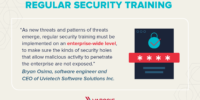In today’s digitally connected world, the landscape of cybersecurity is dynamic and constantly evolving. Cyber threats continue to grow in sophistication, making it crucial for organizations to stay ahead through effective cyber threat intelligence practices. In this guide, we’ll explore quick tips to help you bolster your cyber threat intelligence efforts and enhance your organization’s security posture. ️
1. Understanding Cyber Threat Intelligence
Cyber threat intelligence involves the collection and analysis of information about potential and current cyber threats. Understand the different types of threat intelligence, including strategic, tactical, and operational, to tailor your approach based on your organization’s needs.
2. Establishing a Threat Intelligence Program
Create a structured and well-defined threat intelligence program within your organization. This program should include processes for data collection, analysis, dissemination, and feedback loops. Having a formalized program ensures consistency and effectiveness in threat intelligence efforts.
3. Continuous Monitoring and Analysis
Implement continuous monitoring of your organization’s networks and systems. Leverage automated tools and technologies to collect real-time data. Regularly analyze this data to identify patterns, anomalies, and potential threats in their early stages.
4. Collaboration and Information Sharing
Establish collaborations with other organizations, both within and outside your industry. Participate in information-sharing initiatives, such as Information Sharing and Analysis Centers (ISACs). Shared intelligence can provide valuable insights into emerging threats.
5. Focus on Threat Actor TTPs ️
Understand the Tactics, Techniques, and Procedures (TTPs) employed by threat actors. Analyzing TTPs helps in identifying the likely source of an attack and enables proactive defense measures. Stay updated on the latest TTPs used by different threat groups.
6. Utilize Threat Feeds and Platforms
Integrate threat intelligence feeds and platforms into your security infrastructure. These feeds provide real-time information about known threats, indicators of compromise (IOCs), and vulnerabilities. Automated integration helps in timely threat detection.
7. Incident Response Planning
Develop and regularly update an incident response plan. A well-prepared incident response plan ensures a swift and coordinated response to a cyber threat. Test the plan through simulations to identify areas for improvement.
8. Employee Training and Awareness
Invest in cybersecurity training for employees to enhance their awareness of potential threats. Human error is a common entry point for cyberattacks, and well-informed employees serve as an additional layer of defense.
9. Adopt Threat Hunting Techniques
Implement proactive threat hunting techniques to actively search for signs of malicious activity within your network. Threat hunting involves skilled analysts using various tools to identify threats that may evade traditional security measures.
10. Regularly Update and Patch Systems ️
Keep your systems, software, and applications up to date with the latest security patches. Regular updates help in closing potential vulnerabilities that threat actors might exploit. Implement a patch management process to ensure timely updates.
Conclusion: Building Resilience Against Cyber Threats ️
As cyber threats become more sophisticated, organizations must prioritize effective cyber threat intelligence practices. By implementing the quick tips outlined in this guide, you can strengthen your defenses, stay ahead of evolving threats, and build resilience against cyberattacks. Remember, cybersecurity is an ongoing effort, and staying informed is key to maintaining a robust security posture.








